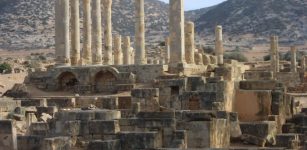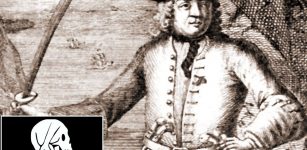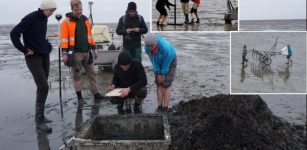Is The Tomb Of Genghis Khan Hidden And Protected In The Khentii Mountains Because Some Fear It’s Cursed?
Ellen Lloyd - AncientPages.com - What ancient secrets are hidden in the Khentii Mountains? Is the tomb of the great warrior Genghis Khan hidden deep inside the mountains? Is this the reason why this region is a protected zone that we are not allowed to enter?
Credit: Adobe Stock - Andrey Burmakin
The location of the tomb of Genghis Khan remains an unsolved ancient mystery. Finding the burial place of the 13th-century warrior, conqueror, and imperial ruler would be one of the greatest archaeological discoveries of all time. Still, all attempts to locate the ancient tomb have failed so far. Is it because the tomb of Genghis Khan is deliberately hidden and protected from the outside world because some fear it’s cursed?
Ancient Secrets Of Sacred Burkhan Khaldun Mountain – Protected And Forbidden Zone
Many experts believe Genghis Khan was buried somewhere in a valley near the sacred Mongolian mountain of Burkhan Khaldun, near his birthplace in Khentii Aimag, northeastern Mongolia.
Great Burkhan Khaldun Mountain and its surrounding landscape lie in the central part of the Khentii Mountains chain that forms the watershed between the Arctic and Pacific Oceans.
Burkhan Khaldun Mountain - Image credit: Wikipedia
It is believed that Genghis Khan built a beautiful place in the Khentii Mountains, called the Great Taboo or Ikh Khorig, by the Mongols. According to an ancient legend Genghis Khan stated that this was the place where he wanted to be buried.
Many historians suspect Genghis Khan’s tomb was a vast necropolis deep inside the mountains. After the construction was completed, all tomb builders were executed to conceal the secret. Even the soldiers who killed the builders of the tomb were executed. One historical source holds that 10,000 horsemen “trampled the ground so as to make it even.” Another source states a forest was planted over the site to hide the leader in his final resting place.
Today, it’s challenging to judge how much of this is true, but there are reasons to suspect the tomb of Genghis Khan, the Great Khan and founder of the Mongol Empire is really buried somewhere in the Khentii Mountains.
Investigating the region and looking for Khan’s tomb is easier said than done because the Mongolian government forbids access to the site.
For 800 years, Mongolia's sacred mountain, Burkhan Khaldun, associated with Genghis Khan's origin, has been part of the Khan Khentii Strictly Protected Area. Tourists and travelers are forbidden to enter this remote area.
Genghis Khan as portrayed in a 14th-century Yuan era album; the original version was black and white. The original size is 47 cm wide and 59.4 cm high. Paint and ink on silk. Now located in the National Palace Museum, Taipei, Taiwan. Credit: Public Domain
Some years ago, an expedition supported by the University of California, San Diego, and the National Geographic Society was granted permission to explore the mountain range. National Geographic’s Valley of the Khans Project and archaeologist Fredrik Hiebert used satellite imagery to identify potential locations for the burial site of Genghis Khan and then “ground-truthed” the areas with GPR to determine their viability.
The tomb of Genghis Khan was not found. Are we looking in the wrong place, or is it simply very well hidden?
Fear The Tomb Of Genghis Khan Is Cursed
Many traditional Mongolians are afraid Khan's tomb is cursed. Some fear finding Genghis Khan's tomb will bring about the end of the world.
People connect the search for Khan's tomb with the discovery of the resting place of Timur, a 14th Century Turko-Mongol military leader who conquered most of the Muslim world, central Asia, and parts of India.
When Timur died in 1405, his tomb was inscribed with one of the most convincing curses in history, reading: "When I rise from the dead, the world shall tremble."
The quest for Khans' tomb will continue. The Genghis Khan statue complex Ulaanbaatar, Mongolia. Credit: Adobe Stock - Nuttee
Another inscription on his casket read: "Whomsoever opens my tomb shall unleash an invader more terrible than I." Russian archaeologists ignored the warning and opened the tomb. Three days later, Adolf Hitler launched Operation Barbarossa, the largest-ever military invasion of the Soviet Union.
Many think that opening the cursed tomb of Timur tomb triggered some of the biggest struggles of World War 2, and they worry something similar might happen if Genghis Khan's tomb is located and opened.
According to historian John Man finding the tomb in Mongolia would have 'geopolitical repercussions'
In his book Genghis Khan: Life, Death, and Resurrection, he wrote: “Many people in China believe Mongolia, like Tibet, should be part of China, as it was under Kublai Khan.
"If China succeeds in establishing mining rights in Mongolia and a dominance over that industry, then Genghis’s tomb might become a focal point for political ambitions, the like of which we have never seen.”
Interestingly, not one single artifact has been found that belonged to the leader who killed more than 40 million people.
Perhaps some things are not meant to be found...
Updated on November 27, 2023
Written By Ellen Lloyd - AncientPages.com
Copyright © AncientPages.com All rights reserved. This material may not be published, broadcast, rewritten or redistributed in whole or part without the express written permission of AncientPages.com
Expand for referencesMore From Ancient Pages
-
 University Of Warsaw Archaeologists Return To Study Large Ancient City Of Ptolemais
Archaeology | Sep 8, 2023
University Of Warsaw Archaeologists Return To Study Large Ancient City Of Ptolemais
Archaeology | Sep 8, 2023 -
 Egyptian Artisans In The Valley Of The Kings Had Permanent Jobs In The Time Of The Pharaohs
Featured Stories | Apr 11, 2022
Egyptian Artisans In The Valley Of The Kings Had Permanent Jobs In The Time Of The Pharaohs
Featured Stories | Apr 11, 2022 -
 Fragment Of Unique Ancient Greek Terracotta Statue Uncovered In Underwater Diggings
Archaeology | Mar 26, 2017
Fragment Of Unique Ancient Greek Terracotta Statue Uncovered In Underwater Diggings
Archaeology | Mar 26, 2017 -
 Giant 7,000-Year-Old Astronomical Calendar Discovered In Poland?
Archaeology | Dec 22, 2017
Giant 7,000-Year-Old Astronomical Calendar Discovered In Poland?
Archaeology | Dec 22, 2017 -
 Vast Paleogenetic Study Reveals Insights On Migration, Farming And Language Development Across The Southern Arc
Archaeology | Aug 26, 2022
Vast Paleogenetic Study Reveals Insights On Migration, Farming And Language Development Across The Southern Arc
Archaeology | Aug 26, 2022 -
 Amazing Tomb Of Yuya And Tjuyu Filled With Ancient Treasures In The Valley Of The Kings
Featured Stories | Jun 2, 2021
Amazing Tomb Of Yuya And Tjuyu Filled With Ancient Treasures In The Valley Of The Kings
Featured Stories | Jun 2, 2021 -
 Scientists Reconstruct The Climate Of The Ancient World Using Small Wooden Artifacts And Mummies
Archaeology | Apr 5, 2023
Scientists Reconstruct The Climate Of The Ancient World Using Small Wooden Artifacts And Mummies
Archaeology | Apr 5, 2023 -
 On This Day In History: A Solar Eclipse Occurs, As Predicted By Thales Of Miletus – On May 28, 585 BC
News | May 28, 2016
On This Day In History: A Solar Eclipse Occurs, As Predicted By Thales Of Miletus – On May 28, 585 BC
News | May 28, 2016 -
 Jolly Roger – Symbol Of Golden Age Piracy
Ancient History Facts | Jan 22, 2017
Jolly Roger – Symbol Of Golden Age Piracy
Ancient History Facts | Jan 22, 2017 -
 Runic Inscription On The Forsa Ring Is Not What We First Thought – Scientists Say
Archaeology | Aug 15, 2024
Runic Inscription On The Forsa Ring Is Not What We First Thought – Scientists Say
Archaeology | Aug 15, 2024 -
 30,000-Year-Old Hidden Writing Found At Sacsayhuamán Temple Could Re-Write History
Civilizations | Jun 24, 2014
30,000-Year-Old Hidden Writing Found At Sacsayhuamán Temple Could Re-Write History
Civilizations | Jun 24, 2014 -
 Surprising Discovery Of Unique 3,500- Year-Old Arrowheads Made Of Shells In The Jotunheimen Mountains
Archaeology | Feb 20, 2023
Surprising Discovery Of Unique 3,500- Year-Old Arrowheads Made Of Shells In The Jotunheimen Mountains
Archaeology | Feb 20, 2023 -
 Lost Since 1362: Researchers Discover The Church Of Rungholt – A Sunken Medieval Trading Place
Archaeology | May 25, 2023
Lost Since 1362: Researchers Discover The Church Of Rungholt – A Sunken Medieval Trading Place
Archaeology | May 25, 2023 -
 ‘Bad King John’ Of England: His Lost Treasures Have Never Been Found
Featured Stories | Apr 6, 2016
‘Bad King John’ Of England: His Lost Treasures Have Never Been Found
Featured Stories | Apr 6, 2016 -
 Large Fortress And Wall Uncovered On The Nile Delta Mark Power Of Egypt’s Canal Of the Pharaohs
Archaeology | Dec 29, 2017
Large Fortress And Wall Uncovered On The Nile Delta Mark Power Of Egypt’s Canal Of the Pharaohs
Archaeology | Dec 29, 2017 -
 Puzzling Water Glyphs Of The American Southwest – Ancient Astronomical Symbols, Directional Signs Or Something Else?
Featured Stories | Apr 15, 2023
Puzzling Water Glyphs Of The American Southwest – Ancient Astronomical Symbols, Directional Signs Or Something Else?
Featured Stories | Apr 15, 2023 -
 Was Organized Society A Disruptive Or Calming Force In Ancient Andes Populations?
Archaeology | Oct 24, 2024
Was Organized Society A Disruptive Or Calming Force In Ancient Andes Populations?
Archaeology | Oct 24, 2024 -
 Massive trophy skull rack discovered in the Aztec ruins
Artifacts | Aug 22, 2015
Massive trophy skull rack discovered in the Aztec ruins
Artifacts | Aug 22, 2015 -
 Mystery Of Lama Dashi-Dorzho Itigilov: A Mummy Whose Body Defies Time
Featured Stories | Sep 21, 2018
Mystery Of Lama Dashi-Dorzho Itigilov: A Mummy Whose Body Defies Time
Featured Stories | Sep 21, 2018 -
 Sumerians Built A Huge ‘Anti-Drought Machine’ To Save Ancient City Of Girsu From Destruction
Ancient Technology | Nov 23, 2023
Sumerians Built A Huge ‘Anti-Drought Machine’ To Save Ancient City Of Girsu From Destruction
Ancient Technology | Nov 23, 2023




